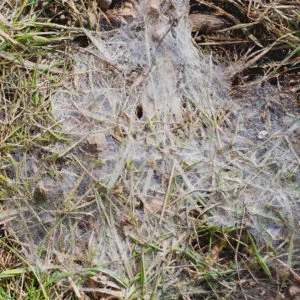On warm summer evenings, light brown moths flutter and fly low over lawns. These long-snouted moths are harmless, however, their larvae, sod webworm caterpillars, are not so innocent. Sod webworm damage turns your turf into a mottled mess. Here’s how to recognize if these pests are the problem.
Why Worry About Sod Webworms?
Webworm moths lay eggs in spring and their caterpillar larvae create silk-like tunnels in the thatch or top layer of turf. Here, they remain in close proximity to their food source, the grass. Cool-season turf, like Kentucky bluegrass, tastes best to these pests. Brown with dark heads and spots on their bodies, these caterpillars are approximately 1/2” long in size. A few of the ravenous creatures won’t do much harm, but an infestation means major problems for your landscaping.
Sod Webworm Damage
Detecting sod webworm damage confuses many because it’s often mistaken for other forms of damage. Dog urine, drought, or other pests cause the same sickly symptoms in grass. As webworms devour the grass, small brown patches appear in otherwise green turf. Spring leads into summer, and these patches of dead or half-eaten grass grow in size, eventually taking over the better part of a lawn. The worst of sod webworm damage shows up from the middle to end of summer in sunny or dry areas of the yard.
Determining the culprit of the devastated grass is step one. Dig into the lawn’s thatch layer or topsoil. If you see a silky maze of tunnels and/or the caterpillars themselves, you know it’s sod webworm damage. Another method uses a mix of dish detergent and water. Pour the soapy solution on damaged areas. After a few minutes, the spotted pests appear if they are lurking beneath the surface.
What to Do About Sod Webworm Damage
Now that you know sod webworms are the culprit, consider taking a natural approach to control them.
- Using the soapy solution works well on smaller infestations. When caterpillars emerge, simply scoop them up and get rid of them.
- However, a serious infestation requires more than detergent. Try biological controls like beneficial nematodes. These tiny living things feed on caterpillars. Purchase them at a local garden center.
- Another non-chemical approach is bacillus thuringiensis B.t., a type of bacteria that is toxic to the larvae. Apply it in late afternoon to ensure it works when the caterpillars feed at night.
- Lastly, if you reseed your lawn, use grass seed labeled “endophyte enhanced” which means it’s engineered to resist certain pests.
We Can Help
Severe infestations require immediate attention and possibly the use of chemical pesticides. Call in an expert to handle it. Contact Free Spray Lawn Care today at 419-529-5296.



Comments (0)
Thanks for your comment!
Thanks for your feedback! Your comments have been successfully submitted! Please note, all comments require admin approval prior to display.
Error submitting comment!
There is a problem with your comment, please see below and try again.